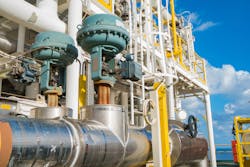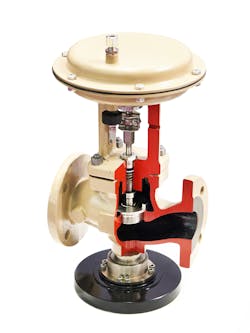Optimized valve design for improved field performance
Pipeline and oilfield flowline safety is a key concern for oil and gas operators and contractors alike. Critical to the safe operation of the flowline is the use of gate valves to isolate hydrocarbon flow at any given time, providing a secure way to mitigate against pipeline failure and meet high industry standards for safe performance.
All gate valves use actuators, which are linear motion devices that open and close the valve, making them critical to the safety of the flowline system. Some gate valves are pneumatically actuated, requiring control pressure to operate. Pneumatic actuators can work autonomously with no on-site personnel or manual operation required. With safety being paramount, the actuator must comply with industry standards for operation and automatically close when a catastrophic loss of control pressure occurs.
Safety is not the only concern, however. Valve design should also address the system’s environmental impact, not only preventing pipeline leakage but also performing efficiently with minimal energy consumption. Process manufacturers can achieve this by using low-pressure system design and valve optimization, taking advantage of carbon reduction opportunities.
Additional efficiency gains come from using lightweight, dynamic components that require less energy to operate. The less energy a valve and actuator system consumes, the lower the carbon footprint and the more sustainable the system becomes.
Method of operation
The pneumatic gate valve operates when pneumatic control pressure enters the actuator’s pressure chamber and the actuator’s extended stem travels downward. An adjustable down stop prevents any further downward movement.
The actuator contains a fabric-reinforced diaphragm with a large surface area to interact with the pneumatic control pressure. The pneumatic control pressure is applied to the top side of the diaphragm to actuate the valve into the open position, typically in a downward direction.
A spring, located on the bottom side of the diaphragm, continuously exerts an upward force to close the valve when control pressure is removed. The spring also acts as a failover switch, automatically closing the valve in the event of a catastrophic loss of control pressure.
As the stem actuates downward, it passes through a stem seal that separates the pipeline or flowline fluid from the actuator. The stem seal is a critical component in the valve system and must not leak — any leakage could damage the actuator and result in a system shutdown. Stem seals are tested to industry standards for zero leakage and longevity.
Remotely controlled
Gate valves are usually controlled from a remote site, often miles away from their physical location in the pipeline. Pressure sensors alert operators to close and isolate hydrocarbon flow when necessary. This isolation allows for maintenance of the pipeline, as well as mitigation of risk, should damage or a potential pipeline failure occur. The continued reliable performance of a pipeline is essential to avoid costly repairs, replacement or even abandonment.
Recent changes in the American Petroleum Institute (API) specifications for industry standards to improve the oil and gas industry’s safety performance require manufacturers to optimize existing designs to meet the new API certifications for equipment.
Design optimization
Recognizing the importance of continued design optimization and the need to comply with evolving industry standards, Trelleborg Sealing Solutions routinely partners with valve and actuator manufacturers, contributing its in-depth knowledge, pipeline protection experience and bespoke sealing solutions to help tackle the challenge of continually improving the performance, reliability and efficiency of gate valve systems.
For instance, collaborating with an oilfield equipment manufacturer to optimize the design of its pneumatic diaphragm valve actuator, Trelleborg engineered a bespoke, premium-grade, high-quality, nylon fabric-reinforced rubber rolling diaphragm that resisted fatigue following hundreds of open/close cycles. The diaphragm was tested for burst pressure resistance, to prevent catastrophic failure.
The interface of the diaphragm to the actuator housing is leak-free, and a bespoke diaphragm bead feature assures zero leakage to the environment. Trelleborg conducted finite element analysis (FEA) to confirm load and movement of the rolling diaphragm and optimize the diaphragm’s overall performance.
The rolling diaphragm design eliminates unwanted movement, reducing fatigue, tearing and the need for maintenance, ultimately increasing seal life. The actuator’s modular design is optimized for simplicity, ease of maintenance and adaptability, with fewer components than traditional actuators.
The actuator’s nylon fabric-reinforced rubber diaphragm has a large piston area (surface area) allowing for the use of a low-pressure air or gas control system. At a maximum control pressure of just 150 psi, the system is safer, more efficient, easier to operate and subject to less wear and tear than higher pressure options.
With certification to the latest API 6D and 6A standards, the pneumatic diaphragm valve actuator is simple, easy to maintain and adaptable. The diaphragm inside the actuator uses a rubber material resistant to oxidation and chemical degradation. The diaphragm material’s superior flexibility and fatigue-resistance provide leak-free, reliable actuation over the rated life of the actuator, extending maintenance cycles and reducing wasted energy.
Summary
Selecting the right solution for a specific valve application and its working environment will prevent pipeline and flowline fatigue and damage, subsequently reducing operation and maintenance costs by maximizing the life of the field.
By increasing the safety and efficiency of gate valve systems through design optimization, performance improvements can lead to carbon reduction opportunities and field life extension. Fail-safe enhancements can provide additional redundancy in the system, preventing leakage from the pipeline and ensuring compliance with environmental regulations.
Eric Bucci is the Global Technical Manager for the Energy and Oil & Gas Segment at Trelleborg Sealing Solutions. He has 26 years of experience working at Trelleborg in various positions in engineering and business development, with a focus on segment strategy, knowledge sharing and new product development. Eric holds BS in mechanical engineering from the University of Texas at Austin.
Trelleborg Sealing Solutions
About the Author
Eric Bucci
Global Technical Manager for the Energy and Oil & Gas Segment at Trelleborg Sealing Solutions.
Eric Bucci is the Global Technical Manager for the Energy and Oil & Gas Segment at Trelleborg Sealing Solutions. He has 26 years of experience working at Trelleborg in various positions in engineering and business development, with a focus on segment strategy, knowledge sharing and new product development. Eric holds BS in mechanical engineering from the University of Texas at Austin.

